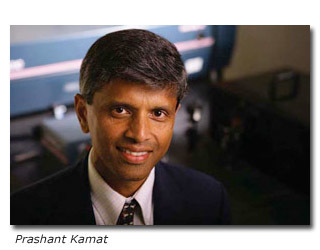
Prashant Kamat has recently published a feature article titled “Quantum Dot Solar Cells. Semiconductor Nanocrystals as Light Harvesters” which was featured on the front cover of the Journal of Physical Chemistry.
Kamat is a professor of chemistry and biochemistry and senior scientist at the Radiation Laboratory, and concurrent professor in the Department of Chemical and Biomolecular Engineering.
Abstract
The emergence of semiconductor nanocrystals as the building blocks of nanotechnology has opened up new ways to utilize them in next generation solar cells. This paper focuses on the recent developments in the utilization of semiconductor quantum dots for light energy conversion. Three major ways to utilize semiconductor dots in solar cell include (i) metal-semiconductor or Schottky junction photovoltaic cell (ii) polymer-semiconductor hybrid solar cell, and (iii) quantum dot sensitized solar cell. Modulation of band energies through size control offers new ways to control photoresponse and photoconversion efficiency of the solar cell. Various strategies to maximize photoinduced charge separation and electron transfer processes for improving the overall efficiency of light energy conversion are discussed. Capture and transport of charge carriers within the semiconductor nanocrystal network to achieve efficient charge separation at the electrode surface remains a major challenge. Directing the future research efforts toward utilization of tailored nanostructures will be an important challenge for the development of next generation solar cells.
Read the feature article, “Quantum Dot Solar Cells. Semiconductor Nanocrystals as Light Harvesters."